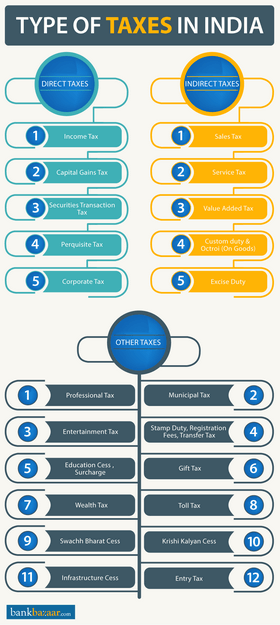Types of Taxes
Taxes are of two distinct types: direct and indirect taxes. The difference comes in the way these taxes are implemented. Some are paid directly by you, such as the dreaded income tax, wealth tax, corporate tax, etc., while others are indirect taxes, such as the value-added tax, service tax, sales tax, etc.
- Direct Taxes
- Indirect Taxes
But, besides these two conventional taxes, there are also other taxes that have been brought into effect by the Central Government to serve a particular agenda. ‘Other taxes’ are levied on both direct and indirect taxes, such as the recently introduced Swachh Bharat Cess tax, Krishi Kalyan Cess tax, and infrastructure Cess tax, among others.
1. Direct Tax
Direct taxes, as stated earlier, are taxes that are paid directly by you. These taxes are levied directly on an entity or an individual and cannot be transferred onto anyone else. One of the bodies that overlooks these indirect taxes is theCentral Board of Direct Taxes (CBDT), which is a part of the Department of Revenue. It has, to help it with its duties, the support of various acts that govern various aspects of direct taxes.
Some of these acts are:
Income Tax Act:
ᱱᱚᱣᱟ ᱫᱚ 1961ᱨᱮᱭᱟᱜ ᱟᱤ. ᱴᱤ. ᱟᱫᱷᱤᱱᱤᱭᱚᱢ ᱞᱮᱠᱟ ᱛᱮᱦᱚᱸ ᱵᱟᱰᱟᱭᱚᱠ ᱟ ᱟᱨ ᱵᱷᱟᱨᱚᱛ ᱨᱮ ᱟᱭᱠᱨ ᱵᱟᱦᱟᱞᱤᱭ ᱱᱤᱭᱚᱢ ᱠᱚ ᱜᱚᱴᱟᱭᱟ. The income, which this act taxes, can come from any source, like a business, owning a house or property, gains received from investments and salaries, etc. This is the act that defines how much the tax benefit on a fixed deposit or a life insurance premium will be. It is also the act that decides how much of your income you can save through investments and what the slab for the income tax will be.
Wealth Tax Act:
The Wealth Tax Act was enacted in 1951 and is responsible for the taxation related to the net wealth of an individual, a company, or a Hindu Unified Family. ᱫᱷᱚᱱ ᱢᱟᱥᱩᱞ ᱨᱮᱭᱟᱜ ᱡᱚᱛᱚ ᱠᱷᱚᱱ ᱟᱞᱜᱟ ᱦᱤᱸᱥᱟᱵ ᱱᱚᱣᱟ ᱛᱟᱦᱮᱸ ᱠᱟᱱ ᱡᱮ ᱡᱩᱫᱤ ᱢᱤᱠᱩᱴ ᱫᱷᱚᱱ ᱴᱟᱠᱟ30 ᱞᱟᱠᱷ ᱵᱟᱲᱛᱤ ᱟ, ᱤᱱᱟ ᱛᱟᱭᱚ 1% ᱪᱟᱠᱟ ᱨᱮᱭᱟᱜ ᱚᱠᱟ ᱴᱟᱠᱟ 30 ᱞᱟᱠᱷ ᱵᱟᱲᱛᱤ ᱟ ᱢᱟᱥᱩᱞ ᱞᱮᱠᱟ ᱛᱮ ᱮᱢ ᱞᱮᱱᱟ . 2015 ᱨᱮᱞᱟᱹᱭ ᱥᱚᱫᱚᱨ ᱵᱚᱡᱚᱴ ᱨᱮ ᱱᱚᱣᱟ ᱪᱟᱣᱟ ᱦᱚᱪᱚ ᱞᱮᱱ. ᱩᱱ ᱠᱷᱚᱱ ᱱᱚᱣᱟ ᱩᱱᱠᱩ ᱦᱚᱲᱚ ᱠᱚ ᱨᱮ12% ᱨᱮᱭᱟᱜ ᱵᱟᱲᱛᱤ ᱵᱷᱟᱨ ᱥᱟᱸᱣ ᱥᱟᱦᱟ ᱦᱚᱪᱚ ᱟᱠᱟᱱᱟ ᱚᱠᱟ ᱴᱟᱠᱟ1ᱠᱟᱨᱚᱲ ᱥᱮᱨᱢᱟ ᱯᱤᱪᱷᱤ ᱠᱷᱚᱱ ᱵᱟᱲᱛᱤ ᱟᱨᱡᱟᱣᱟ. ᱱᱚᱣᱟ ᱮᱱᱟ ᱠᱚᱢᱯᱟᱱᱤ ᱨᱮ ᱦᱚᱸ ᱵᱟᱦᱟᱞᱚᱠ ᱟ ᱚᱠᱚᱭ ᱴᱮᱱ ᱴᱟᱠᱟ 10 ᱠᱟᱨᱚᱲ ᱥᱮᱨᱢᱟ ᱨᱮ ᱵᱟᱲᱛᱤ ᱨᱟᱡᱥᱣ ᱢᱮᱱᱟᱜ ᱟ. The new guidelines drastically increased the amount the government would collect in taxes as opposed to the amount they would collect through the wealth tax.
Gift Tax Act:
The Gift Tax Act came into existence in 1958 and stated that if an individual received gifts, monetary or valuable, as gifts, a tax was to be paid on such gifts. The tax on such gifts was maintained at 30%, but it was abolished in 1998. Initially, if a gift was given and it was something like property, jewellery, shares, etc., it was taxable. According to the new rules, gifts given by family members like brothers, sisters, parents, spouses, aunts, and uncles are not taxable. Even gifts given to you by the local authorities are exempt from this tax. How the tax works now is that if someone, other than the exempt entities, gifts you anything that exceeds a value of Rs. 50,000, then the entire gift amount is taxable.
Expenditure Tax Act:
ᱱᱚᱣᱟ ᱢᱤᱫ ᱚᱱᱠᱟᱱ ᱠᱟᱹᱢᱤ ᱠᱟᱱᱟ ᱚᱠᱟ 1987 ᱨᱮ ᱪᱤᱱᱦᱟᱹ ᱨᱮ ᱦᱚᱡ ᱮᱢᱟ ᱟᱨ ᱢᱤᱫ ᱦᱚᱴᱮᱞ ᱟᱨ ᱵᱟᱝ ᱨᱮᱥᱛᱨᱟᱸ ᱨᱮᱭᱟᱜ ᱠᱟᱹᱢᱤ ᱠᱚ ᱨᱮᱭᱟᱜ ᱞᱟᱵ ᱦᱟᱛᱟᱣᱟ ᱢᱤᱫ ᱦᱚᱲ ᱞᱮᱠᱟᱛᱮ ᱟᱢ ᱫᱟᱨᱟᱭ ᱛᱮ ᱠᱚᱨᱟᱣ ᱠᱷᱚᱨᱚᱪ ᱥᱟᱸᱣ ᱥᱚᱢᱵᱚᱸᱫᱷ ᱢᱮᱱᱟᱜ ᱟ. It is applicable to all of India except Jammu and Kashmir. ᱱᱚᱣᱟ ᱵᱤᱥᱮᱥ ᱠᱷᱚᱨᱚᱪ ᱠᱚ ᱮᱢ ᱦᱩᱭᱩᱜ ᱟ ᱡᱩᱫᱤ ᱩᱱᱠᱩ ᱴᱟᱠᱟ 3,000 ᱦᱚᱴᱮᱞ ᱟᱨ ᱢᱤᱫ ᱨᱮ ᱥᱴᱩᱨᱮᱸᱴ ᱨᱮ ᱦᱩᱭᱩᱜᱟᱜ ᱡᱚᱛᱚ ᱠᱷᱚᱨᱪ ᱨᱮᱭᱟᱜ ᱢᱟᱢᱞᱟ ᱨᱮ ᱵᱟᱹᱲᱛᱤ ᱟ.
Interest Tax Act:
1974 ᱨᱮᱭᱟᱜ ᱥᱩᱫ ᱢᱟᱥᱩᱞ ᱟᱫᱷᱤᱱᱤᱭᱚᱢ ᱛᱤᱱᱟᱹᱜ ᱵᱤᱥᱮᱥ ᱯᱚᱨᱤᱥᱛᱷᱤᱛᱤ ᱨᱮ ᱟᱨᱡᱟᱱ ᱥᱩᱫ ᱨᱮ ᱮᱢ ᱢᱟᱥᱩᱞ ᱥᱟᱸᱣ ᱥᱚᱢᱵᱚᱸᱫᱷ ᱢᱮᱱᱟᱜ ᱟ. In the last amendment to the act, it was stated that the act does not apply to interest that was earned after March 2000.
Below are some examples for all the different types of direct taxes:

Examples of Direct Taxes
These are some of the direct taxes that you pay
ᱮ) ᱟᱨᱡᱟᱣ ᱢᱟᱥᱩᱞ:
ᱱᱚᱣᱟ ᱡᱚᱛᱚ ᱠᱷᱚᱱ ᱵᱮᱥ- ᱵᱟᱰᱟᱭ ᱟᱨ ᱥᱚᱢ ᱵᱩᱡᱷᱟᱹᱣᱟᱜ ᱢ ᱟᱥᱩᱞ ᱠᱷᱚᱱ ᱢᱤᱫ ᱠᱟᱱᱟ. It is the tax that is levied on your earnings in a financial year. ᱟᱨᱡᱟᱣ ᱢᱟᱹᱥᱩᱞ ᱨᱮᱭᱟᱜ ᱟᱹᱰᱤᱜᱟᱱ ᱯᱟᱹᱦᱞᱩ ᱢᱟᱱᱜ ᱟ, ᱡᱮᱞᱮᱠᱟ ᱴᱮᱠᱥ ᱥᱞᱮᱵ, ᱢᱟᱥᱩᱞ ᱞᱮᱠ ᱟᱨᱡᱟᱣ, ᱥᱚᱛ ᱨᱮ ᱢᱟᱥᱩᱞ ᱜᱮᱫ (ᱴᱤ. ᱰᱤ. ᱮᱥ.) ᱢᱟᱥᱩᱞ ᱞᱮᱠᱟ ᱟᱨᱡᱟ ᱨᱮ ᱠᱮᱢᱤ, ᱮᱢᱟᱱ. The tax is applicable to both individuals and companies. ᱦᱚᱲ ᱠᱚ ᱞᱟᱹᱜᱤᱫ, ᱩᱱᱠᱩ ᱚᱠᱟ ᱢᱟᱥᱩᱞ ᱦᱟᱞᱟ ᱦᱩᱭᱩᱜ ᱟ, ᱩᱱᱠᱩ ᱱᱚᱣᱟ ᱠᱟᱛᱷᱟ ᱨᱮ ᱛᱟᱵᱮ ᱠᱚ ᱛᱟᱦᱮᱸᱱᱟ ᱡᱮ ᱚᱠᱟ ᱢᱟᱥᱩᱞ ᱵᱷᱤᱛᱤᱨ ᱨᱮ ᱦᱤᱡᱩᱜ ᱟ. ᱱᱚᱣᱟ ᱵᱨᱮᱠᱮᱴ ᱟᱨ ᱵᱟᱝ ᱥᱞᱮᱵ ᱜᱚᱴᱟᱣᱟᱜ ᱥᱮᱨᱢᱟ ᱟᱨᱡᱟᱣ ᱞᱮᱠᱟ ᱛᱮ ᱟᱹᱫᱟᱹᱭ ᱦᱚᱪᱚᱣᱟᱜ ᱢᱟᱥᱩᱞ ᱠᱚ ᱜᱮᱴᱟᱭᱟ ᱟᱨ ᱪᱮᱛᱟᱱ ᱟᱨ ᱡᱟᱣ ᱫᱚᱞ ᱠᱚ ᱞᱟᱹᱜᱤᱫ ᱵᱮᱜᱚᱨ ᱢᱟᱥᱩᱞ ᱠᱷᱚᱱ ᱤᱫᱤᱠᱟᱛᱮ30% ᱢᱟᱥᱩᱞ ᱦᱟᱵᱤᱡ ᱦᱩᱭᱩᱜ ᱟ.
The government has fixed different tax slabs for varied groups of individuals, namely general taxpayers, senior citizens (people aged between 60 to 80, and very senior citizens (people aged above 80).
b)Capital Gains Tax:
This is a tax that is payable whenever you receive a sizable amount of money. It could be from an investment or from the sale of a property. ᱱᱚᱣᱟ ᱥᱟᱫᱷᱟᱨᱚᱱ ᱞᱮᱠᱟᱛᱮ ᱵᱟᱨ ᱞᱮᱠᱟᱱᱟᱜ ᱦᱩᱭᱩᱜ ᱟ, ᱠᱚᱢ ᱠᱷᱚᱱ ᱠᱚᱢ36 ᱪᱟᱸᱫᱚ ᱞᱟᱹᱜᱤᱫ ᱛᱮ ᱱᱤᱣᱮᱥ ᱠᱷᱚᱱ ᱧᱟᱢ ᱠᱚᱢ ᱚᱠᱛᱚ ᱯᱩᱸᱡᱤᱜᱛ ᱞᱟᱵ ᱟᱨ 36ᱪᱟᱸᱫᱚ ᱠᱷᱚᱱ ᱵᱟᱲᱛᱤ ᱚᱠᱛᱚ ᱞᱟᱹᱜᱤᱫ ᱱᱤᱣᱮᱥ ᱠᱷᱚᱱ ᱡᱤᱞᱤᱧ ᱚᱠᱛᱚ ᱯᱩᱸᱡᱤᱜᱛ ᱞᱟᱵ . The tax applicable for each is also very different since the tax on short term gains is calculated based on the income bracket that you fall in and the tax on long term gains is 20%. The interesting thing about this tax is that the gain doesn’t always have to be in the form of money. It could also be an exchange in kind, in which case the value of the exchange will be considered for taxation.
ᱥᱤ.) ᱡᱟᱹᱯᱛᱤ ᱮᱯᱮᱢ ᱴᱮᱠᱥ:
ᱱᱚᱰᱮ ᱡᱟᱦᱟᱱ ᱫᱟᱱᱟᱝᱟᱜ ᱵᱟᱱᱩᱜ ᱟ ᱡᱩᱫᱤ ᱟᱢ ᱵᱟᱰᱟᱭᱟ ᱥᱮᱭᱟᱨ ᱵᱟᱡᱟᱨ ᱨᱮ ᱥᱩᱦᱤ ᱦᱚᱨ ᱛᱮ ᱪᱮᱫ ᱞᱮᱠᱟ ᱵᱮᱯᱟᱨᱟ, ᱟᱨ ᱡᱟᱹᱯᱛᱤᱡᱟᱹᱯᱛᱤ ᱨᱮ ᱵᱚᱯᱟᱨ ᱢᱮ, ᱮᱱᱠᱷᱟᱱ ᱟᱢ ᱵᱟᱲᱛᱤ ᱢᱟᱛᱨᱟ ᱨᱮ ᱯᱩᱭᱥᱟ ᱛᱮᱭᱟᱨ ᱞᱟᱹᱜᱤᱫ ᱛᱤᱸᱜᱩ ᱟᱠᱟᱱᱟ. This too is a source of income, but it has its own tax, which is known as the Securities Transaction Tax. How this tax is levied is by adding the tax to the price of the share. ᱱᱚᱣᱟ ᱨᱮᱭᱟᱜ ᱢᱟᱱᱮ ᱡᱮ ᱡᱚᱛᱚ ᱚᱠᱟᱛᱮ ᱛᱤᱱ ᱨᱮ ᱟᱢ ᱥᱮᱭᱟᱨ ᱠᱤᱨᱤᱧ ᱟᱨ ᱵᱟᱝ ᱟᱠᱷᱨᱤᱧᱟ, ᱮᱱᱠᱷᱟᱱ ᱟᱢ ᱱᱚᱣᱟ ᱢᱟᱥᱩᱞ ᱨᱮᱭᱟᱜ ᱴᱟᱠᱟ ᱮᱢᱟ. All securities traded on the Indian stock exchange have this tax attached to them.
ᱰᱤ.)ᱟᱱᱩᱞᱟᱵ ᱢᱟᱥᱩᱞ:
Perquisites are all the perks or privileges that employers may extend to employees. ᱱᱚᱣᱟ ᱵᱤᱥᱮᱥ ᱦᱚᱠ ᱠᱮ ᱨᱮ ᱠᱚᱢᱯᱟᱱᱤ ᱫᱟᱨᱟᱭ ᱛᱮ ᱮᱢ ᱢᱤᱫ ᱚᱲᱟᱜ ᱟᱨ ᱵᱟᱝ ᱟᱢᱟᱜ ᱵᱮᱵᱷᱟᱨ ᱞᱟᱹᱜᱤᱫ ᱢᱤᱫ ᱫᱟᱨ ᱥᱟᱹᱢᱤᱞ ᱦᱩᱭ ᱫᱟᱲᱮᱭᱟᱜ ᱟ, ᱚᱠᱟ ᱟᱢ ᱠᱚᱢᱯᱟᱱᱤ ᱫᱟᱨᱟᱭ ᱛᱮ ᱮᱢ ᱟᱠᱟᱱᱟ. These perks are not just limited to big compensation like cars and houses; they can even include things like compensation for fuel or phone bills. How this tax is levied is by figuring out how that perk has been acquired by the company or used by the employee. In the case of cars, it may be so that a car provided by the company and used for both personal and official purposes is eligible for tax, whereas a car used only for official purposes is not.
ᱮ) ᱠᱚᱨᱯᱚᱨᱮᱴ ᱢᱟᱥᱩᱞ:
Corporate tax is the income tax that is paid by companies from the revenue they earn. This tax also comes with a slab of its own that decides how much tax the company has to pay. For example, a domestic company, that has a revenue of less than Rs. 1 crore per annum won’t have to pay this tax, but one that has a revenue of more than Rs. 1 crore per annum will have to pay this tax. It is also referred to as a surcharge and is different for different revenue brackets. It is also different for international companies, where the corporate tax may be 41.2% if the company has a revenue of less than Rs. 10 million and so on.
There are four different types of corporate tax.
- Minimum Alternative Tax:
ᱠᱚᱢ ᱩᱛᱟᱹᱨ ᱮᱴᱟᱜ ᱢᱟᱥᱩᱞ ᱟᱨ ᱵᱟᱽᱝ ᱮᱢ. ᱮ. ᱴᱤ., ᱢᱩᱞ ᱞᱮᱠᱟ ᱛᱮ ᱟᱭᱠᱟᱨ ᱣᱤᱵᱷᱟᱜ ᱞᱟᱹᱜᱤᱫ ᱠᱚᱢᱯᱟᱱᱤ ᱠᱚ ᱠᱚᱢ ᱩᱛᱟᱹᱨ ᱢᱟᱥᱩᱞ ᱨᱮᱭᱟᱜ ᱴᱟᱠᱟ ᱮᱢ ᱦᱚᱪᱚ ᱨᱮᱭᱟᱜ ᱢᱤᱫ ᱦᱚᱨ ᱠᱟᱱᱟ ᱚᱠᱟ ᱥᱩᱭᱫᱚᱢ 18.5%ᱛᱤᱸᱜᱩᱱᱟ. ᱭᱠᱨ ᱟᱫᱸᱤᱱᱤᱭᱚᱢ ᱨᱮᱭᱟᱜ ᱫᱷᱟᱨᱟ 115 ᱡᱮ. ᱮ. ᱣᱟᱜ ᱮᱦᱚᱵᱚᱵ ᱨᱮᱭᱟᱜ ᱢᱟᱫᱷᱭᱢ ᱛᱮ ᱢᱟᱥᱩᱞ ᱨᱮᱭᱟᱜ ᱱᱚᱣᱟ ᱨᱩᱯ ᱠᱚ ᱵᱟᱦᱟᱞ ᱦᱚᱪᱚ ᱞᱮᱱ ᱛᱟᱦᱮᱸᱱᱟ. ᱮᱱ ᱨᱮᱦᱷᱸ, ᱤᱱᱯᱷᱟᱨᱟ ᱥᱴᱨᱟᱠ ᱪᱟᱨ ᱟᱨ ᱯᱟᱣᱟᱨ ᱥᱚᱠᱴᱟᱨ ᱥᱟᱸᱣ ᱡᱚᱲᱟᱣ ᱛᱮ ᱪᱷᱟᱹᱰ ᱮᱢ ᱟᱠᱟᱱᱟ.
Once a company pays the MAT, it can carry the payment forward and set-off (adjust) against regular tax payable during the subsequent five-year period, subject to certain conditions.
- Fringe Benefit Tax:
Fringe Benefit Tax, or FBT, was a tax that applied to almost every fringe benefit an employer provided to their employees. ᱱᱚᱣᱟ ᱢᱟᱥᱩᱞ ᱨᱮ, ᱟᱹᱰᱤᱜᱟᱱ ᱯᱟᱹᱦᱞᱩ ᱠᱚ ᱞᱟᱢᱤᱞ ᱞᱮᱫ ᱠᱚ ᱛᱟᱦᱮᱸᱱᱟ. Some of them include:
ᱟᱤ.) ᱡᱟᱛᱨᱟ ( ᱮᱞ. ᱴᱤ. ᱮ.),ᱠᱟᱹᱢᱤᱭᱟᱹ ᱵᱷᱟᱹᱞᱟᱹᱤ ᱛᱟᱦᱮᱸᱱ ᱚᱲᱟᱜ ᱟᱨ ᱨᱥᱠᱟ ᱨᱚᱢᱚᱡ ᱨᱮ ᱟᱪᱩᱭᱤᱡᱟᱜ ᱠᱷᱚᱨᱚᱪ.
ii) Any regular commute or commute related expense provided by an employer.
iii) ᱢᱤᱫ ᱥᱮᱣᱟ ᱮᱢ ᱥᱮᱣᱟᱱᱤᱣᱨᱤᱛ ᱠᱟᱸᱰ ᱨᱮ ᱟᱹᱪᱩᱭᱤᱡᱟᱜ ᱮᱱᱮᱢ.
iv) ᱟᱪᱩᱭᱤᱡᱟᱜ ᱥᱴᱚᱠ ᱮᱯᱴᱟᱛ ᱯᱚᱱᱛᱷᱟ (ᱤ. ᱮᱥ. ᱚ. ᱯᱤ. ᱮᱥ.).
ᱮᱯᱷ. ᱵᱤ. ᱴᱤ. ᱵᱷᱟᱨᱚᱛ ᱥᱚᱨᱠᱟᱨᱟᱜ ᱥᱴᱮᱵᱟᱨᱰᱥᱤᱯ ᱵᱷᱤᱛᱤᱨ ᱟᱯᱨᱮᱞ 1, 2005 ᱠᱷᱚᱱ ᱮᱦᱚᱵ ᱞᱮᱱ ᱛᱟᱦᱮᱸᱱᱟ. However, the tax was later scrapped in 2009 by then- Finance Minister Pranab Mukherjee during the 2009 Union Budget session.
- Dividend Distribution Tax:
2007’ ᱠᱮᱱᱫᱨᱤᱭ ᱵᱚᱡᱚᱴ ᱨᱮᱭᱟᱜ ᱢᱩᱪᱟᱫ ᱛᱟᱭᱚᱢ ᱞᱟᱵᱦᱤᱸᱥ ᱦᱟᱹᱴᱤᱧ ᱢᱟᱥᱩᱞ ᱩᱯᱨᱩᱢ ᱞᱮᱱ ᱛᱟᱦᱮᱸᱱᱟ. It is basically a tax levied on companies based on the dividend they pay to their investors. This tax is applicable on the gross or net income an investor receives from their investment. ᱱᱮ ᱦᱟᱞᱤ, 15% ᱨᱮ ᱰᱤ. ᱰᱤ. ᱴᱤ. ᱫᱚᱨ ᱛᱤᱸᱜᱩᱱᱟ.
- Banking Cash Transaction Tax:
Banking Cash Transaction Tax is yet another form of tax that has been abandoned by the Indian government. This form of taxation was in operation from 2005-2009 until then FM Pranab Mukherjee nullified the tax. ᱱᱚᱣᱟ ᱢᱟᱥᱩᱞ ᱥᱚᱞᱟᱦ ᱮᱢ ᱟᱠᱟᱫ ᱟ ᱡᱮ ᱡᱚᱛᱚ ᱵᱮᱸᱠ ᱮᱯᱥ (ᱰᱮᱵᱤᱴ ᱟᱨ ᱵᱟᱝ ᱠᱨᱮᱰᱤᱴ) ᱨᱮ0.1% ᱨᱮᱭᱟᱜ ᱫᱚᱨ ᱛᱮ ᱢᱟᱥᱩᱞ ᱞᱟᱜᱟᱣᱟ.
2. Indirect Tax:
By definition, indirect taxes are those taxes that are levied on goods or services. They differ from direct taxes because they are not levied on a person who pays them directly to the government, they are instead levied on products and are collected by an intermediary, the person selling the product. The most common examples of indirect tax Indirect tax can be VAT (Value Added Tax), Taxes on Imported Goods, Sales Tax, etc. These taxes are levied by adding them to the price of the service or product, which tends to push the cost of the product up.
Examples of indirect taxes:
These are some of the common indirect taxes that you pay.
a) Sales Tax:
As the name suggests, a sales tax is a tax that is levied on the sale of a product. This product can be something that was produced in India or imported and can even cover services rendered. This tax is levied on the seller of the product, who then transfers it onto the person who buys said product, with the sales tax added to the price of the product. The limitation of this tax is that it can be levied only once for a particular product, which means that if the product is sold a second time, sales tax cannot be applied to it.
ᱢᱩᱞ ᱞᱮᱠᱟ ᱛᱮ, ᱫᱤᱥᱚᱢ ᱨᱮᱭᱟᱜ ᱡᱚᱛᱚ ᱨᱟᱡᱭ ᱟᱠᱚᱣᱟᱜ ᱱᱤᱡᱮ ᱟᱠᱷᱨᱤᱧ ᱢᱟᱥᱩᱞ ᱚᱫᱷᱤᱱᱤᱭᱚᱢ ᱨᱮᱭᱟᱜ ᱯᱟᱞᱚᱱᱟ ᱟᱨ ᱥᱣᱫᱮᱥᱤ ᱯᱨᱛᱤᱥᱛ ᱨᱮᱭᱟᱜ ᱯᱷᱤ ᱦᱟᱛᱟᱣᱟ. Besides this, a few states also levy other additional charges like turnover tax, purchase tax, work transaction tax, and the like. This is also the reason why sales tax is one of the largest revenue generators for various state governments. Also, this tax is levied under both central and state legislation.
b) Service Tax:
ᱡᱮ ᱞᱮᱠᱟ ᱵᱷᱟᱨᱚᱛ ᱨᱮ ᱟᱠᱷᱨᱤᱧᱮᱠ ᱥᱟᱢᱟᱱ ᱨᱮᱭᱟᱜ ᱫᱚᱨ ᱨᱮ ᱥᱮᱞᱥ ᱴᱮᱠᱥ ᱥᱮᱞᱮᱫᱟ, ᱚᱱᱠᱟ ᱜᱮ ᱥᱟᱨᱣᱤᱥ ᱴᱮᱠᱥ ᱵᱷᱟᱨᱚᱛ ᱨᱮ ᱧᱟᱢ ᱦᱚᱪᱚᱣᱟᱜ ᱥᱮᱣᱟ ᱨᱮ ᱥᱮᱞᱮᱫᱟ. ᱵᱚᱡᱚᱴ2015,ᱨᱮᱭᱟᱜ ᱯᱟᱲᱦᱟᱣ ᱨᱮ, ᱱᱚᱣᱟ ᱨᱚᱲ ᱞᱮᱱ ᱛᱟᱦᱮᱸᱟ ᱡᱮ ᱥᱮᱣᱟ ᱢᱟᱥᱩᱞ 12.36% ᱠᱷᱚᱱ 14% ᱦᱟᱵᱤᱡ ᱵᱟᱲᱟᱦᱟᱣᱟ. ᱱᱚᱣᱟ ᱥᱟᱢᱟᱱ ᱨᱮ ᱫᱮ ᱵᱟᱝ ᱢᱮᱱᱠᱷᱟᱱ ᱚᱱᱟ ᱠᱚᱢᱯᱟᱱᱤ ᱨᱮ ᱞᱟᱜᱩᱜ ᱟ ᱚᱠᱟ ᱥᱮᱣᱟ ᱮᱢᱮᱫ ᱟ ᱟᱨ ᱥᱮᱣᱟ ᱠᱚ ᱚᱠᱟ ᱞᱮᱠᱟ ᱛᱮ ᱮᱢᱟ, ᱱᱚᱣᱟ ᱟᱫᱷᱟᱨ ᱛᱮ ᱡᱚᱛᱚ ᱪᱟᱸᱫᱚ ᱟᱨ ᱵᱟᱝ ᱢᱤᱫ ᱫᱷᱟᱣ ᱡᱚᱛᱚ ᱯᱮᱪᱟᱸᱫᱚ ᱨᱮ ᱛᱩᱢᱟᱞ ᱡᱟᱨᱣᱟᱭᱟ. If the establishment is an individual service provider, then the service tax is paid only once the customer pays the bills; however, for companies, the service tax is payable the moment the invoice is raised, irrespective of the customer paying the bill.
An important thing to remember is that since the service at a restaurant is a combination of the food, the waiter, and the premises themselves, it is difficult to pin point what qualifies for service tax. ᱡᱟᱦᱟᱸ ᱜᱮ ᱵᱟᱝ ᱯᱩᱥᱴᱟᱹᱣ ᱠᱚ ᱥᱟᱦᱟᱭ ᱞᱟᱹᱜᱤᱫ, ᱱᱚᱣᱟ ᱥᱚᱸᱵᱚᱸᱫᱷ ᱨᱮ ᱱᱚᱣᱟ ᱨᱚᱲ ᱥᱚᱫᱚᱨ ᱟᱠᱟᱱᱟ ᱡᱮ ᱨᱮᱥᱛᱟᱨᱟᱸ ᱨᱮ ᱥᱮᱣᱟ ᱢᱟᱹᱥᱩᱞ ᱢᱚᱴ ᱵᱤᱞ ᱨᱮᱭᱟᱜ ᱮᱠᱮᱱ 40% ᱨᱮ ᱞᱟᱜᱟᱣ ᱦᱚᱪᱚᱭᱟ.
ᱡᱤ. ᱮᱥ. ᱴᱤ. ᱫᱚ ᱢᱚᱫ ᱩᱯᱵᱷᱚᱜ- ᱜᱩᱰᱥ ᱮᱸᱰ ᱥᱟᱨᱣᱤᱥᱴᱮᱠᱥ:
ᱥᱟᱢᱟᱱ ᱠᱚ ᱟᱨ ᱥᱮᱣᱟ ᱢᱟᱥᱩᱞ (ᱡᱤ. ᱮᱥ. ᱴᱤ) ᱵᱷᱟᱨᱚᱛ ᱨᱮᱭᱟᱜ ᱵᱟᱝ ᱥᱚᱡᱷᱮ ᱢᱟᱥᱩᱞ ᱵᱮᱱᱟᱣ ᱨᱮ ᱡᱟᱛᱟ ᱠᱷᱚᱱ ᱢᱟᱨᱟᱝ ᱥᱩᱦᱤ ᱠᱟᱱᱟ ᱪᱮᱫᱟᱜ ᱡᱮ ᱵᱟᱡᱟᱨ ᱢᱚᱴᱟᱢᱩᱴᱤ ᱢᱤᱫ ᱥᱮᱨᱢᱟ ᱢᱟᱲᱟᱝ25 ᱮᱦᱚᱵᱞᱮᱫ ᱛᱟᱦᱮᱸᱱᱟ. ᱡᱤ. ᱮᱥ. ᱴᱤ. ᱫᱚ ᱢᱤᱫ ᱩᱯᱵᱷᱚᱜ-ᱟᱫᱷᱟᱨᱤᱛ ᱢᱟᱥᱩᱞ ᱞᱟᱜᱟᱣ ᱟᱨ ᱢᱟᱥᱩᱞ ᱨᱮᱭᱟᱜ ᱫᱚᱨ ᱨᱟᱡᱭ ᱫᱟᱨᱟᱭ ᱛᱮ ᱜᱚᱴᱟ ᱦᱚᱪᱚᱭᱟ. ᱮᱢ ᱛᱤᱨᱭᱟᱹᱣ ᱨᱮ ᱩᱯᱵᱷᱚᱜ ᱨᱮᱭᱟᱜ ᱡᱚᱛᱚ ᱡᱷᱟᱸᱯ ᱨᱮ ᱜᱚᱱᱚᱝ ᱰᱷᱮᱨ ᱡᱤᱱᱤᱥ ᱠᱚ ᱟᱨ ᱥᱮᱣᱟ ᱠᱚ ᱨᱮ ᱡᱤ. ᱮᱥ. ᱴᱤ. ᱞᱟᱜᱟᱣᱟ. ᱡᱤᱱᱤᱥ ᱠᱚ ᱟᱨ ᱥᱮᱣᱟ ᱠᱚ ᱠᱚᱨᱚᱧ ᱨᱮ ᱮᱢ ᱡᱤ. ᱮᱥ. ᱴᱤ. ᱡᱤᱱᱤᱥ ᱠᱮ ᱟᱨ ᱥᱮᱣᱟ ᱠᱮ ᱨᱮᱭᱟᱜ ᱮᱢ ᱤᱫᱤ ᱨᱮ ᱮᱢ ᱡᱤ. ᱮᱥ. ᱴᱤ. ᱵᱤᱨᱩᱫ ᱜᱮᱴᱟ ᱦᱚᱪᱚ ᱫᱟᱲᱮᱭᱟᱜ ᱟ, ᱵᱮᱯᱟᱨᱤ ᱞᱟᱹᱜᱩ ᱡᱤ. ᱮᱥ. ᱴᱤ. ᱫᱚᱨ ᱨᱮᱭᱟᱜ ᱴᱚᱠᱚ ᱮᱢᱟ ᱢᱮᱱᱠᱷᱟᱱ ᱴᱮᱠᱥ ᱠᱨᱮᱰᱤᱴ ᱛᱚᱛᱨᱚ ᱨᱮᱭᱟᱜ ᱢᱟᱫᱷᱭᱟᱢ ᱛᱮ ᱨᱩᱣᱟᱹᱲ ᱫᱟᱵᱤ ᱫᱟᱲᱮᱭᱟᱜ ᱟ.
c) Value Added Tax:
VAT, also known as commercial tax, is not applicable on commodities that are zero-rated (e.g., food and essential drugs) or those that fall under exports. This tax is levied at all the stages of the supply chain, right from the manufacturers, dealers, and distributors to the end user.
The value-added tax is a tax that is levied at the discretion of the state government, and not all states implemented it when it was first announced. The tax is levied on various goods sold in the state, and the amount of the tax is decided by the state itself. For example, in Gujarat, the government split all the goods into various categories called schedules. There are 3 schedules, and each schedule has its own VAT percentage. For Schedule 3 the VAT is 1%, for Schedule 2 the VAT is 5%; and so on. ᱡᱤᱱᱤ ᱠᱚ ᱚᱠᱟ ᱡᱟᱦᱟᱸ ᱪᱟᱱᱟᱪ ᱨᱮᱜᱮ ᱵᱟᱭ ᱦᱟᱹᱴᱤᱧ ᱟᱠᱟᱱᱟ. ᱚᱱᱟ ᱨᱮᱭᱟᱜ ᱵᱷᱤ. ᱮ. ᱴᱤ. 15% ᱨᱮᱭᱟᱜ ᱠᱟᱱᱟ.
d) Custom duty & Octroi:
When you purchase anything that needs to be imported from another country, a charge is applied to it, and that is the customs duty. It applies to all the products that come in via land, sea, or air. Even if you bring in products bought in another country to India, a customs duty can be levied on them. The purpose of the customs duty is to ensure that all goods entering the country are taxed and paid for. ᱡᱟᱦᱟᱸ ᱞᱮᱠᱟ ᱥᱤᱢᱟᱹ ᱯᱷᱤ ᱱᱚᱣᱟᱭ ᱜᱚᱴᱟᱭᱟ ᱡᱮ ᱮᱴᱟᱜ ᱫᱤᱥᱚᱢ ᱞᱟᱹᱜᱤᱫ ᱥᱟᱢᱟᱱ ᱨᱮ ᱢᱟᱥᱩᱞ ᱞᱟᱜᱟᱣᱟ, ᱚᱠᱴᱨᱚᱭ ᱱᱚᱣᱟ ᱜᱚᱴᱟ ᱞᱟᱹᱜᱤᱫ ᱵᱷᱟᱨᱚᱛ ᱨᱮᱭᱟᱜ ᱵᱷᱤᱛᱤᱨ ᱨᱟᱡᱭ ᱨᱮᱭᱟᱜ ᱥᱤᱢᱟᱹ ᱠᱚ ᱯᱟᱨᱚᱢ ᱦᱚᱪᱚᱣᱟᱜ ᱥᱟᱢᱟᱱ ᱨᱮ ᱩᱪᱤᱛ ᱢᱟᱥᱩᱞ ᱞᱟᱜᱟᱣ ᱢᱟ. It is levied by the state government and functions in much the same way as customs duty does.
e) Excise Duty:
This is a tax that is levied on all the goods manufactured or produced in India. It is different from customs duty because it is applicable only on things produced in India and is also known as the Central Value Added Tax, or CENVAT. This tax is collected by the government from the manufacturer of the goods. It can also be collected from those entities that receive manufactured goods and employ people to transport the goods from the manufacturer to themselves.
The Central Excise Rule set by the central government suggests that every person that produces or manufactures any 'excisable goods', or who stores such goods in a warehouse, will have to pay the duty applicable to such goods. Under this rule, no excisable goods, on which any duty is payable, will be allowed to move without payment of duty from any place where they are produced or manufactured.














